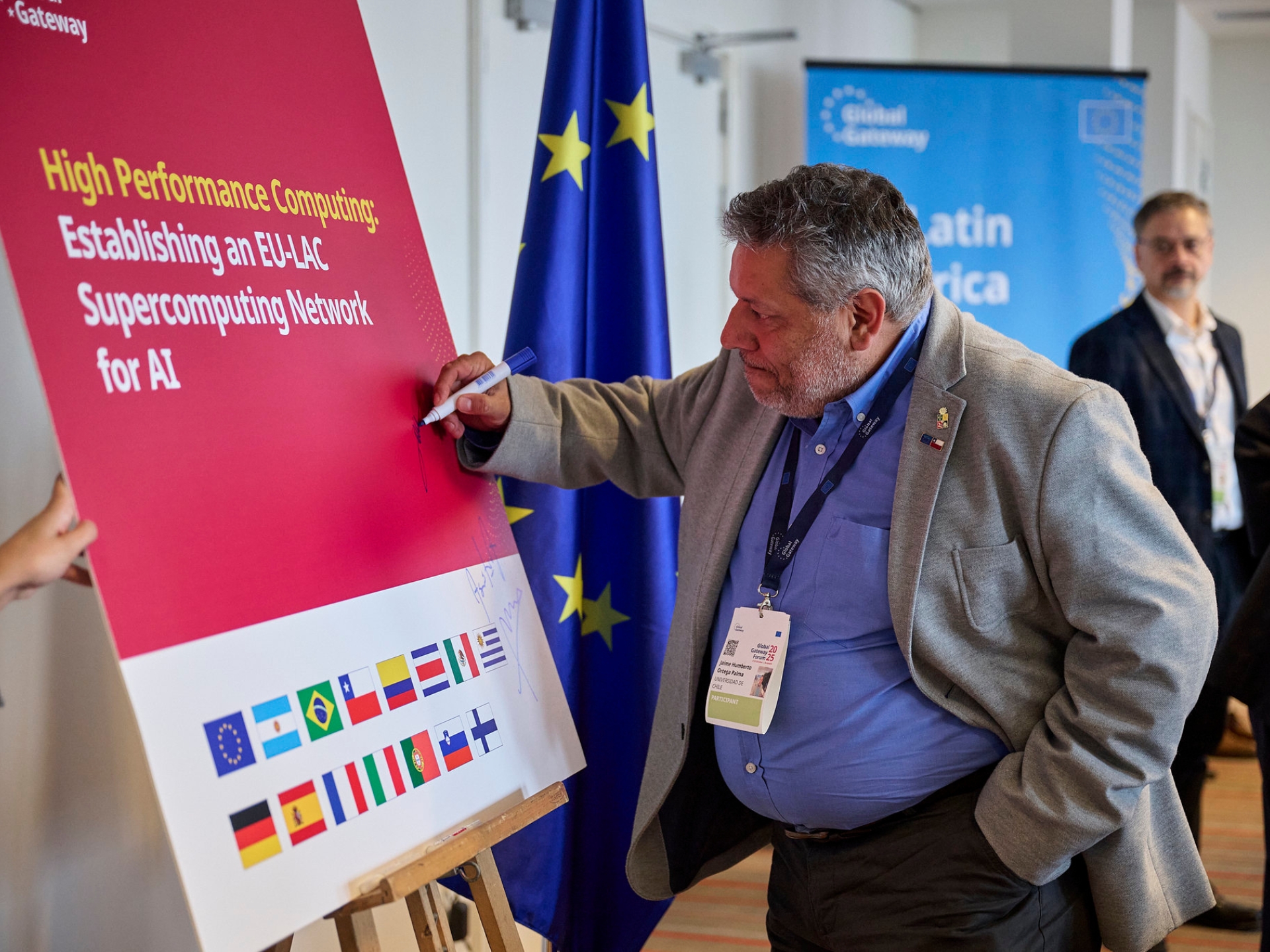
- The National Laboratory for High Performance Computing (NLHPC), part of the Infrastructure Area of the Center for Mathematical Modeling (CMM) at the University of Chile, played an active role in the EU–LAC Supercomputing Network Scaling Session, held on October 10, 2025, in Brussels, as part of the Global Gateway Forum organized by the European Commission.
During the session, an international cooperation agreement was formalized to strengthen supercomputing capabilities and promote collaborative scientific research between Europe, Latin America, and the Caribbean, in response to the rapid rise of artificial intelligence (AI) and the need for secure, sustainable, and high-performance digital infrastructure.
The newly established EU–LAC Bi-regional Supercomputing Network will connect existing infrastructures, build new capacities, and open opportunities for joint innovation between both continents, supported under the European Union’s Global Gateway Strategy, which seeks to promote fair and sustainable digital transformation worldwide.
Commissioner for International Partnerships, Jozef Síkela, said: “The EU–LAC Supercomputing Network shows how the Global Gateway creates real value for people and businesses on both sides of the Atlantic. Through the Global Gateway, we are together investing over €12 million in the infrastructure and knowledge that will power tomorrow’s innovations – from fighting climate change to developing new medicines and advancing artificial intelligence. This is a win for Europe, Latin America, and the Caribbean.”
Minister of Foreign Affairs, European Union and Cooperation of Spain, José Manuel Albares, declared: “The launch of this Network represents the implementation of a key tool enabling the EU and Latin America and the Caribbean to work together on Artificial Intelligence, reducing gaps to ensure a fair digital transition”.
The NLHPC was represented by Professor Jaime Ortega, Principal Investigator at the Center for Mathematical Modeling (CMM), who participated in the meeting as a regional leader in high-performance computing infrastructure, reinforcing Chile’s role as one of the main supercomputing hubs in Latin America.
“Being part of this network allows us to strengthen scientific collaboration between Europe and Latin America, share capabilities, and move toward a more integrated and sovereign digital infrastructure,” said Professor Ortega after the signing of the agreement.
A Roadmap for Bi-regional Cooperation
As part of the EU–LAC Digital Alliance, the Joint Declaration of Intent signed by directors of High-Performance Computing (HPC) centers from the European Union and Latin America lays the foundation for the design, development, and implementation of the EU–LAC Supercomputing Network.
The initiative builds upon previous European programs that connected scientific and technical communities across both regions. Within this framework, the European Commission, together with the European High-Performance Computing Joint Undertaking (EuroHPC JU), has committed to supporting the creation of this network to enhance existing HPC resources in Latin America and the Caribbean, promote interconnection with the European ecosystem, and strengthen cooperation in research, innovation, and digital sovereignty.
As Chile’s national supercomputing infrastructure and part of the CMM’s Infrastructure Area, the NLHPC played a pivotal role in this milestone. Its participation underscores Chile’s leadership in the development and application of high-performance technologies for science, industry, and the public sector.
“This agreement marks a turning point for our region. It will enable us to join a world-class scientific collaboration network, providing access to advanced computational capabilities and fostering joint projects in strategic areas such as climate change, artificial intelligence, and digital health”, said Ginés Guerrero, Executive Director of the NLHPC.
Main objectives of the network:
- Promote shared high-performance computing capabilities to maximize resource efficiency.
- Enhance technical skills through dedicated training and capacity-building programs.
- Strengthen scientific collaboration through the development of joint use cases.
- Develop and deploy AI-based applications to address social challenges.
- Increase the use of the BELLA cable infrastructure, which digitally connects Europe and Latin America.
The network recognizes the joint investment of the European Union, Brazil, and Spain, as well as the key roles of regional partners such as SCALAC and RedCLARA, in advancing cohesive technical and scientific cooperation across the region.
The session was attended by representatives from the Jülich Supercomputing Centre (Germany), CINECA (Italy), Inria (France), Barcelona Supercomputing Center (Spain), LNCC (Brazil), INESTEC (Portugal), and Cluster-UY (Uruguay), along with ministries and science and technology agencies from Argentina, Colombia, Costa Rica, Uruguay, Finland, Portugal, and Mexico, among others.
Chile and the CMM: A Strategic Position in the Region
With this agreement, the NLHPC, supported by the CMM at the University of Chile, reaffirms its commitment to open, collaborative supercomputing in service of scientific research, consolidating its position as a key partner in bi-regional digital cooperation and strengthening Chile’s role as a leader in scientific and technological infrastructure in Latin America.
By Iván R. Tobar Bocaz, CMM Communications.
Posted on Oct 21, 2025 in News




 Noticias en español
Noticias en español

